How Can Protected Areas Become Hubs for Education for Sustainable Development
For the last year, the Alfred Toepfer Natural Heritage Scholarship supported the work of young conservationists in Protected Areas across Europe. Lucia Cușnir was one of the winners of the Scholarship in 2023 and travelled to Slovakia, Denmark, Hunary and within Romania to learn more about how Protected Areas can implement Education for Sustainable Development.
How Can Protected Areas Become Hubs for Education for Sustainable Development

Protected areas are no longer seen just as conservation zones to protect our natural and cultural heritage — they are increasingly being recognized as dynamic learning classrooms for people of all ages. These landscapes provide powerful opportunities for education, offering immersive, hands-on experiences that connect individuals with nature, culture, and sustainability in meaningful ways.
Education for Sustainable Development (ESD) in protected areas serves as a bridge between conservation efforts and community engagement, ensuring that people not only understand but actively participate in protecting our natural and cultural heritage.
Learning from the Field
This study tries to explore best practices, challenges, and opportunities in implementing ESD initiatives & activities across European protected areas, drawing insights from study visits to Tatra National Park (Slovakia), Lille Vildmose Centre (Denmark), Hortobágy National Park (Hungary), and the Danube Delta Biosphere Reserve (Romania).
Through qualitative research methods, including field observations, stakeholder interviews, and participatory engagement, the study highlights the diverse ways in which protected areas integrate ESD initiatives and activities into their management. Interpretive visitor centers, educational and interpretive trails, guided tours, Junior Ranger programmes, and hands-on conservation activities serve as key tools in fostering environmental awareness and responsibility. Additionally, local engagement through festivals, volunteering initiatives, and citizen science programs reinforces the role of communities in ESD.
Protected areas that prioritize community voices, cultural relevance, and local ownership are more likely to foster long-term conservation engagement.
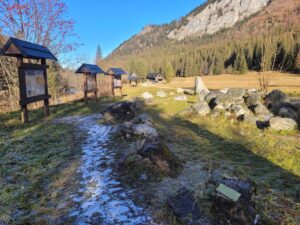
Tatra National Park, Slovakia, photo by Lucia Cușnir
Challenges and Opportunities in ESD
Despite strong local leadership and inspiring examples, many protected areas struggle with the same challenges: underfunding, staff shortages, and rigid policies that don’t reflect field realities. Rangers and educators often work beyond their mandates, driven by passion but lacking support.
However, there are also opportunities. Cross-sectoral partnerships with other protected areas, NGOs, educational institutions, and local authorities can enhance the reach and impact of ESD efforts. By sharing resources, and learning from each other’s experiences, these collaborations can create more resilient and innovative education programs.
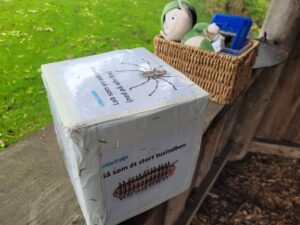
Lille Vildmose Centre, Denmark, photo by Lucia Cușnir
The Way Forward
For ESD to truly thrive in protected areas, it must be supported by policies that reflect real field experiences, and designed with flexibility in mind. Protected areas must also recognize that every ranger on patrol, every school visit, and every community gathering is a moment of education — and an opportunity for stewardship.
As this study shows, education doesn’t just happen through formal strategies. It lives in stories, gestures, trails, shared meals, and simple conversations on the field. ESD isn’t just about delivering information — it’s about sparking curiosity, sharing stories, and leading by example. When people meet the passionate educators and rangers behind conservation, they don’t just learn — they care.
Dive deeper into this topic through the report below!
Read the full report here!Nature for all: A study into how Europe’s Protected Areas are engaging with refugee and asylum seeker communities
For the last year, the Alfred Toepfer Natural Heritage Scholarship supported the work of young conservationists in Protected Areas across Europe. Hayden Bridgeman was one of the winners of the Scholarship in 2023 and travelled to Greece to learn more about how Protected Areas can better engage with marginalised communities such as refugee and asylum seekers.
Nature for all: A study into how Europe’s Protected Areas are engaging with refugee and asylum seeker communities

My name is Hayden Bridgeman and I am a Ranger for the New Forest National Park Authority and a winner of an Alfred Toepfer Scholarship Award. Through this scholarship I have studied how we are engaging with one of our most vulnerable communities in society – refugees and asylum seekers. We, as a society, are so aware of how crucial access to nature is for good mental health and wellbeing, yet those that need it most are often unable to access it. I want to continue to make sure we are doing all we can to change that across our protected landscapes.
I would like to preface my studies by saying I do not have lived experience, but I am an advocate and a friend to this community and want to ensure we are doing all that we can to build cohesive, inclusive communities with nature and mental wellbeing at the heart.
It is vital to remember how important the language we use is in relation to society’s most vulnerable communities. Not only this but it is important to remember that there is a legal difference. Using the wrong terminology can be extremely damaging to communities of displaced people and can have a detrimental effect on their mental health and wellbeing and their journey in acclimatising to a new life.
Asylum Seeker
An asylum seeker is an individual who is seeking international protection. In countries with individualised procedures, an asylum seeker is someone whose claim has not yet been finally decided on by the country in which he or she has submitted it. Not every asylum seeker will ultimately be recognised as a refugee, but every refugee is initially an asylum seeker.
Refugee
A refugee is a person who has fled their country of origin and is unable to or unwilling to return because of a well-founded fear of being persecuted because of their race, religion, nationality, membership of a particular social group or political opinion.
Migrant
An economic migrant is someone who leaves his or her country of origin purely for financial and/or economic reasons. Economic migrants choose to move in order to find a better life and they do not flee because of persecution. Therefore, they do not fall within the criteria for refugee status and are not entitled to receive international protection.
It is imperative that governments/communities/media understand the distinction. Countries have specific responsibilities tied to legislation to help anyone seeking sanctuary and fleeing war and persecution – refugees. It is not the same for migrants.
Through this project I visited three charities in Greece working in both urban environments and National Parks to support refugees and asylum seekers in the outdoors and was able to share in their learning and progress. I was also able to talk directly to individuals that are part of the displaced community and have been able to gather an extensive list of the barriers faced for refugee and asylum seekers accessing nature – it’s important to identify the barriers so that we can find solutions.
It’s an extensive list:
- Expensive or non-existent public transport
- Racial profiling
- Safety concerns
- A lack of family support and often women having to be the sole care giver for children
- Lack of time due to having to navigate lengthy legal processes, acquiring medical assistance and housing
- Low mental health and feeling unwelcome
These are all barriers for everyday life for this community but when accessing nature. As protected area practitioners we can help to remove some of the barriers.

Some brilliant work is taking place with nature connection sessions aiding mental wellbeing and learning how to grow your own food being successful, engaging and beneficial sessions. Something else that was really successful is enabling individuals to carry out citizen science and be a part of community conservation. However transport is and continues to be the biggest barrier to accessing these opportunities.
There are some key take aways on how to make engagement in the outdoors successful:
- Actively listen, ask questions and don’t assume. When creating itineraries for trips and visits ensure you’ve asked what works for the group and what doesn’t. Experiencing nature is not a ‘one size fits all’ mentality, not everyone benefits from a 10km hike, simply being able to sit and talk to others in a green space is enough.
- Start by working in a space that groups know and trust. Take your protected area to this community – whether it’s into a refugee centre, or a local church they meet in to have English lessons.
- Work in partnership with charities that are a trusted contact for this community. This is important for building trust and understanding. Talk to a contact
- Be flexible in your approach and be prepared to rearrange visits if the group need to due to low mental health and anxieties, it can take longer to plan sessions
- Have an outdoor ‘kit library’ from wellies to raincoats that can be a shared and used by multiple groups
- Using google translate to navigate the language barrier as well as having printed photos of the wildlife that’s being talked about in the outdoor environment
- Tea and coffee and picnics are a valuable ice breaker and chance to relax and create a good atmosphere where people feel more comfortable
- Put sustainable and affordable transport at the top of every agenda. If we are to open green spaces to all they must be easy and affordable to navigate through
Whether you are an educator or a policy maker this report aims to help Protected Area professionals continue to create change by not only demonstrating practical tools that can be used but also providing tangible advice and hearing directly from this community themselves on how we can do more and be better in continuing to open green spaces to all.
There is also a network being built for those wanting to swap notes on best practise – please email me to learn more.
Read the full report here!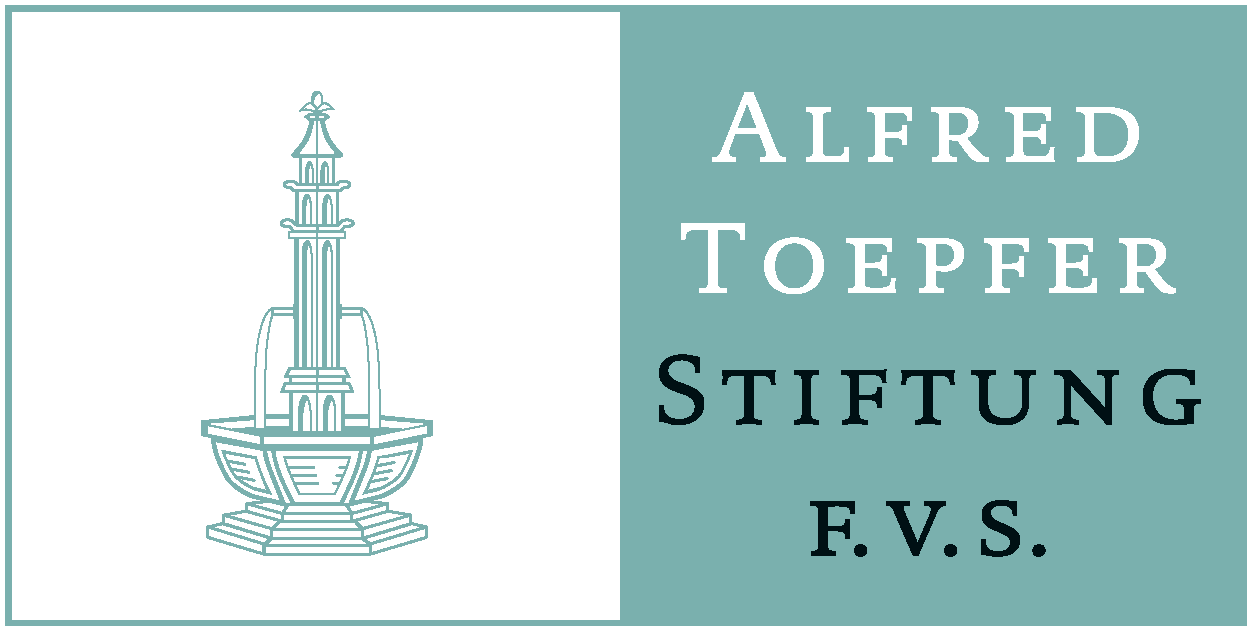
Partners for Conservation: Collaborating Beyond the Conservation Bubble
Pierre Kestemont
Three case studies highlight the importance of working with different partners to achieve holistic conservation efforts.
Partners for Conservation: Collaborating Beyond the Conservation Bubble
There has been much talk in the conservation sector about Public-Private Partnerships to fund nature conservation. In 2022, this was the magic answer to the funding gap for the Kunming-Montreal Global Biodiversity Framework and has since been taken up by the EU and national governments as budgets for traditional nature conservation projects shrink. In order to build these partnerships, we need to consider who our partners are.
Below, the EUROPARC network shares examples of collaborations beyond the conservation bubble to achieve their visions of nature conservation.
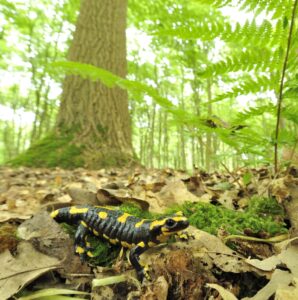
© Vildaphoto – Rollin Verlinde
Case Study 1: Catalysing Scientific research and cooperation in the Forests of Brabant National Park
The Brabant National Park has recognised the critical need to bridge the gap between scientific research and practical conservation efforts and is establishing a scientific council to provide science-based policy advice, translate scientific knowledge to applicable actions, narrow knowledge gaps and promote innovative solutions for conservation and sustainable development.
Full Case StudyCase Study 2: Empowering Park Managers with Tech4Nature
In Catalonia’s Sant Llorenç del Munt i l’Obac Natural Park, a novel partnership between IUCN and Huawei’s TECH4ALL program is using AI, GPS tracking, and solar-powered cameras to protect the endangered Bonelli’s eagle while managing visitor impact. The real-time monitoring system not only alerts managers to immediate threats but also facilitates long-term planning.
Full Case StudyCase Study 3: Green Big Year 2024 Project: Birdwatching around Europe without carbon emission.

©Ponç Feliu
Embarking on an ambitious journey, ornithologist Ponç Feliu had dedicated over a decade to “Green Birding”, a practice of observing birds without relying on fossil fuels. By demonstrating that extensive travel and wildlife observation can be achieved sustainably, Feliu challenges conventional norms and inspires others to consider eco-friendly practices in their pursuits. Engaging with the public has been the key to success, with a crowdfunding campaign to raise funds and engaging with local people through workshops and community events.
Full Case StudyBy working with different stakeholders, like the scientific community, private businesses and the public, conservation efforts can gain more than just funding, they also gain supporters and advocates for our Protected Areas.
Do you have interesting initiatives that you would like to share with us? Or would you like to submit a case study? Please visit our Knowledge Hub!
Uniting Forces for Nature Restoration in Protected Areas – 4 new case studies from across Europe
The Penpont Project Partnership: celebration of diversity. Photo: Action for Conservation
Four case studies of young people, farmers, breeders, landowners and nature conservationists working together on nature restoration.
Uniting Forces for Nature Restoration in Protected Areas
Agriculture and nature conservation are often seen as competing interests, but agriculture practitioners and Protected Areas managers can and must be allies. Farmers, landowners, local stakeholders and young people have come together to unite forces for nature through nature restoration activities. Domesticated animals, such as horses and cattle, are put to work in nature restoration practices resulting in revival of natural conditions.
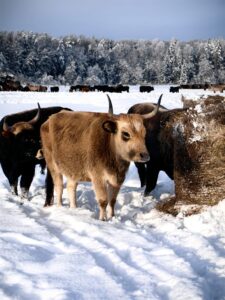
All-weather rewilded species @Kemeri National Park
Case Study 1: Wild Grazing in Ķemeri National Park, Latvia
In 2006 and 2018, large-scale wetland restoration projects were implemented in Ķemeri National Park. These projects included the meandering of two meliorated rivers, setting the stage for wild pasture development. In 2006, the first Konik Polski horses and Auroxen (de-domesticated Heck cattle) were introduced to the restored floodplains. Over time, these wild herds have grown to over 400 individuals, developing natural herd structures, interacting with other wildlife (including large predators), and shaping their environment. With over 20 years of experience, the project has provided valuable insights into natural grazing, highlighting both its ecological benefits and legal challenges.
Full Case Study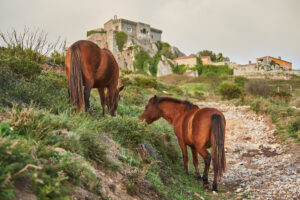
Horses grazing in the landscape @Cascais Ambiente
Case Study 2: Rewilding for Landscape Management in Sintra-Cascais Nature Park, Portugal
This rewilding initiative aims to reintroduce species of locally extinct wild herbivores and their national proxy breeds to function as natural landscape management tools. By reducing the risk of rural fires and promoting ecological restoration, the project is fostering self-sustaining ecosystems. The Functional Herbivory Plan (FHP) determines the specific composition of herbivores—species, breeds, and densities—for each intervention area, tailored to the vegetation and local conditions. Currently, the plan is being implemented over 2,270 hectares, with two monitored areas managed by Cascais Ambiente. These areas are assessed to evaluate the effectiveness of introduced herbivores in managing biomass growth and supporting biodiversity.
Full Case StudyCase Study 3: Sheperd Weeks in Finland
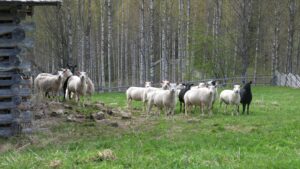
Photo Credit: Metsähallitus / Heidi Kilpeläinen
The Shepherd Weeks are unique way to organize landscape management and conservation efforts. The concept is a combination of nature conservation and management, strengthening relationships between people, nature and landscapes, and enjoying an unforgettable holiday experience.
During the Shepherd Weeks, the landscapes and nature are managed in an exemplary and effective manner that respects traditions and benefits all parties involved. The sheep owners and sheep gain access to quality pastures that may be hard to find, and the shepherds help the farmers with caring for and keeping an eye on the animals. The operations also strengthen the volunteer shepherds’ relationship with landscapes and nature.
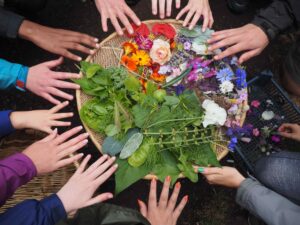
The Penpont Project Partnership: celebration of diversity. Photo: Action for Conservation
Case Study 4: Youth-Led Conservation at Penpont Estate, Wales
Penpont is a 2,000-acre estate in the Bannau Brycheiniog, Wales, home to the Hogg family, tenant farmers, foresters, and artists. Since 2019, the Penpont Project has aimed to achieve bio-cultural restoration and set a global gold standard for youth-led environmental action. Co-managed by a Youth Leadership Group (YLG) of twenty 12-18-year-olds, along with Action for Conservation (AFC), Penpont Estate, and tenant farmers, the project employs eco-cultural mapping tools to visualize past, present, and future land relationships. Developed by indigenous communities, these maps make visible the deep-rooted knowledge and connections to the landscape. Now three years into a major action plan, the project is a beacon of collaboration between youth, conservationists, and land managers.
Full Case StudyThese examples illustrate that nature restoration can be achieved by working together and using diversified tools to achieve the results.
Do you also have an example to share? Send us your case study and join the diversity of voices inspiring and promoting good practices across the EUROPARC network!